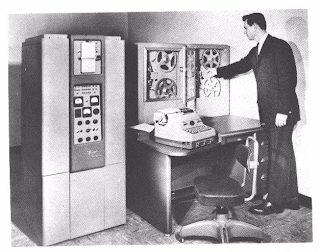WHAT IS A COMPUTER?
The first computers were people. That is, electronic computers (and the earlier mechanical computers) were given this name because they performed the work that had previously been assigned to people. "Computer" was originally a job title: it was used to describe those human beings (predominantly women) whose job it was to perform the repetitive calculations required to compute such things as navigational tables, tide charts, and planetary positions for astronomical almanacs. Imagine you had a job where hour after hour, day after day, you were to do nothing but compute multiplications. Boredom would quickly set in, leading to carelessness, leading to mistakes. And even on your best days you wouldn't be producing answers very fast. Therefore, inventors have been searching for hundreds of years for a way to mechanize (that is, find a mechanism that can perform) this task.
 |
| difference engine |
By 1822 the English mathematician Charles Babbage was proposing a steam driven calculating machine the size of a room, which he called the Difference Engine. This machine would be able to compute tables of numbers, such as logarithm tables. He obtained government funding for this project due to the importance of numeric tables in ocean navigation. By promoting their commercial and military navies, the British government had managed to become the earth's greatest empire. But in that time frame the British government was publishing a seven volume set of navigation tables which came with a companion volume of corrections which showed that the set had over 1000 numerical errors. It was hoped that Babbage's machine could eliminate errors in these types of tables. But construction of Babbage's Difference Engine proved exceedingly difficult and the project soon became the most expensive government funded project up to that point in English history. Ten years later the device was still nowhere near complete, acrimony abounded between all involved, and funding dried up. The device was never finished.
The next breakthrough occurred in America. The U.S. Constitution states that a census should be taken of all U.S. citizens every 10 years in order to determine the representation of the states in Congress. While the very first census of 1790 had only required 9 months, by 1880 the U.S. population had grown so much that the count for the 1880 census took 7.5 years. Automation was clearly needed for the next census. The census bureau offered a prize for an inventor to help with the 1890 census and this prize was won by Herman Hollerith, who proposed and then successfully adopted Jacquard's punched cards for the purpose of computation.
Hollerith's invention, known as the Hollerith desk, consisted of a card reader which sensed the holes in the cards, a gear driven mechanism which could count (using Pascal's mechanism which we still see in car odometers), and a large wall of dial indicators (a car speedometer is a dial indicator) to display the results of the count.
 |
| Hollerith desk |
THE GENERATION OF COMPUTER
First Generation (1940-1956) Vacuum Tubes
The first computers used vacuum tubes for circuitry and
magnetic drums for memory, and were often enormous, taking up entire rooms. They were very expensive to operate and in addition to using a great deal of electricity, generated a lot of heat, which was often the cause of malfunctions.
First generation computers relied on machine language, the lowest-level programming language understood by computers, to perform operations, and they could only solve one problem at a time. Input was based on punched cards and paper tape, and output was displayed on printouts.
The UNIVAC and ENIAC computers are examples of first-generation computing devices. The UNIVAC was the first commercial computer delivered to a businessclient, the U.S. Census Bureau in 1951.
 |
| ENIAC |
Second Generation (1956-1963) Transistors
Transistors replaced vacuum tubes and ushered in the second generation of computers. The transistor was invented in 1947 but did not see widespread use in computers until the late 1950s. The transistor was far superior to the vacuum tube, allowing computers to become smaller, faster, cheaper, more energy-efficient and more reliable than their first-generation predecessors. Though the transistor still generated a great deal of heat that subjected the computer to damage, it was a vast improvement over the vacuum tube. Second-generation computers still relied on punched cards for input and printouts for output.
Second-generation computers moved from cryptic binary machine language to symbolic, or assembly, languages, which allowed programmers to specify instructions in words. High_level progamming languages were also being developed at this time, such as early versions of COBOL and FORTRAN. These were also the first computers that stored their instructions in their memory, which moved from a magnetic drum to magnetic core technology. The first computer of this generation were developed for the atomic energy industry
 |
| second generation computer |
Third Generation (1964-1971) Integrated Circuits
The development of the intregrated circuit was the hallmark of the third generation of computers. Transistors were miniaturized and placed on silicon chips, called semiconductors, which drastically increased the speed and efficiency
of computers.
Instead of punched cards and printouts, users interacted with third generation computers through keyboards and monitors and interfaced with an operating system, which allowed the device to run many different application at one time with a central program that monitored the memory. Computers for the first time became accessible to a mass audience because they were smaller and cheaper than their predecessors.
Fourth Generation (1971-Present) Microprocessors
The microprocessor brought the fourth generation of computers, as thousands of integrated circuits were built onto a single silicon chip. What in the first generation filled an entire room could now fit in the palm of the hand. The Intel 4004 chip, developed in 1971, located all the components of the computer—from the central processing unit and memory to input/output controls—on a single chip.
In 1981 IBM introduced its first computer for the home user, and in 1984 Apple introduced the Macintosh. Microprocessors also moved out of the realm of desktop computers and into many areas of life as more and more everyday products began to use microprocessors. As these small computers became more powerful, they could be linked together to form networks, which eventually led to the development of the Internet. Fourth generation computers also saw the development of GUIs, the mouse and handheld devices.
 |
| macintosh |
Fifth Generation (Present and Beyond) Artificial Intelligence
Fifth generation computing devices, based on artificial intelligence, are still in development, though there are some applications, such as voice recognition, that are being used today. The use of parallel processing and superconductors is helping to make artificial intelligence a reality. Quantum computation and molecular and nanotechnology will radically change the face of computers in years to come. The goal of fifth-generation computing is to develop devices that respond to natural language input and are capable of learning and self-organization.























